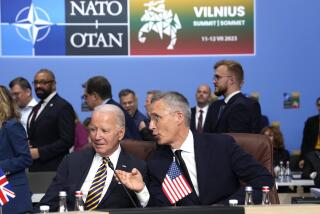Long-Scorned Body Sheds Its Obscurity : Organizations: NATO chooses Conference on Security and Cooperation in Europe to ‘provide a forum for wider political dialogue.’
- Share via
LONDON — After surviving for 15 years without so much as a telephone to call its own, the once-scorned Conference on Security and Cooperation in Europe was tapped Friday by its 16 most powerful members to become the continent’s primary organization for East-West cooperation.
In a communique issued at the end of its London summit conference, the North Atlantic Treaty Organization called for transformation of the conference into a permanent organization, with its own headquarters and bureaucracy, to promote free elections and the rule of law, especially in the emerging democracies in Eastern Europe.
The NATO heads of government said the conference, known by the acronym CSCE, should be “institutionalized to provide a forum for wider political dialogue in a more united Europe.”
The summit suggested creation of a new parliament, to be known as the Assembly of Europe, that would include representatives of all member nations of the conference. It suggested that the new body should be headquartered in one of the new democracies that have replaced the Communist regimes of Eastern Europe.
Support from NATO, which constitutes almost half of the conference’s 35-nation membership, virtually guarantees an enhancement of the role and powers of the conference.
The Soviet Union advocates an even wider mandate for the conference. It advocates converting the conference into a continent-wide security alliance, supplanting both NATO and the Warsaw Pact. The United States and its allies are strongly opposed to going that far because they want to maintain NATO intact.
The conference, often called the Helsinki process because it first met 15 years ago in the Finnish capital, is the only European organization to straddle the ideological divisions of the Cold War successfully. Its membership includes the United States, Canada and all of the nations of Europe except for isolationist Albania.
Although the conference has met frequently over the years, it has never had a permanent structure, relying on employees of the various host countries to handle administrative chores.
The NATO communique emphasized the political role of an enhanced conference, by implication rejecting Moscow’s plan for a new security structure. It said the conference should “set new standards for the establishment and preservation of free societies.”
The communique called on the conference to set up “a mechanism to monitor elections in all CSCE countries.”
In addition, it proposed establishment of a “Center for the Prevention of Conflict that might serve as a forum for exchange of military information . . . and the conciliation of disputes involving CSCE member states.”
NATO called for at least one CSCE meeting a year attended either by presidents and prime ministers or by foreign ministers.
The first CSCE meeting in 1975 ratified the post-World War II boundaries of Europe. At the time, it was denounced by conservatives as putting a stamp of approval on the permanent division of the conflict into democratic and Communist segments. However, the conference also adopted sweeping human rights standards that are now believed to have energized the anti-Communist revolution that swept across Eastern Europe last year.
The United States once was so unenthusiastic about the conference that then-President Gerald R. Ford considered skipping the final session of that first meeting.
More recently, Secretary of State James A. Baker III has endorsed a larger role for the conference, although he said the organization was too cumbersome to take on important security functions.
Under existing procedures, the conference can only act if it has unanimous approval of the 35 members, including such mini-states as Malta and the Vatican.
More to Read
Sign up for Essential California
The most important California stories and recommendations in your inbox every morning.
You may occasionally receive promotional content from the Los Angeles Times.













